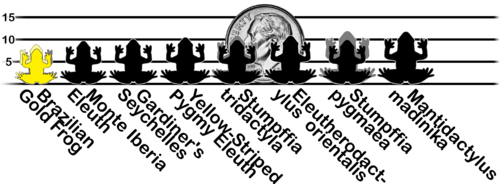Monte Iberia eleuth
| Monte Iberia Eleuth | |
|---|---|
| Scientific classification | |
| Kingdom: | |
| Phylum: | |
| Class: | |
| Order: | |
| Family: | |
| Subfamily: | |
| Genus: | |
| Subgenus: | |
| Species: | E. iberia Estrada & Hedges, 1996
|
| Binomial name | |
| Eleutherodactylus iberia Estrada and Hedges, 1996
| |

| |
| Distribution of E. iberia in Cuba | |
At just over 3/8 inches (9.6 - 9.8 mm) long,[2] the Monte Iberia Eleuth (Eleutherodactylus iberia) is not only the smallest living frog, but is also smaller than any other living tetrapod.[3] It was first discoved in 1996 on Mount Iberia, from which the animal gets its name, and exists in only two small reigons of Cuba. Much remains unknown about this small creature.
Discovery
The diminutive species was first documented by Cuban scientist Alberto R. Estrada of the Institute of Forest Research in Havana, working with S. Blair Hedges of Pennsylvania State University in association with the National Science Foundation's Biotic Surveys and Inventories Program. On a 1996 expedition to Cuchillas de Moa in search of the ivory-billed woodpecker (now believed to be extinct), four iberia specimens were collected after being uncovered under leaf litter and among the roots of ferns in a secondary hardwood forest on the western slope of Monte Iberia.[4] The find was published in the journal Copeia, where the name Eleutherodactylus iberia was introduced. [5][3][6]
Description
E. iberia is physically similar to E. limbatus and E. orientalis, but it is generally darker and the lines on its back do not extend as far to the rear. Because of the extreme minuturization of the species, it posseses fewer teeth than its cousins and a laryngeal apparatus comperable in size to the head of a pin (resulting in a high-pitched call of a series of irregular chirps, comperable to other species of the genus).
Reproductive data is extremely limited. The female specimen which has provided the sole source of data thusfar was found beside an egg, suggesting that iberia lays a single egg in each clutch and that the parents are closely involved in raising the young (as is common with animels who birth few offspring a time).[5]
Habitat
Only two isoloated populations are known to exist, both in the Holguin province of eastern Cuba at elevations under 600 meters.[7] The first location is on top of the Monte Iberia tableland where the frog was discovered. The second is smaller (less than 100km2 and sparcely-occupied, near Nibujón at sea level. This latter area has suffered great disturbances over the past 40 years from human activities.[8]
E. iberia exists in areas of closed rain forest with poorly-drained soil; it requires a great deal of humidity for its survival.[9]
Notes
References
- ^ Template:IUCN2006
- ^ http://www.mypets.net.au/flex/amphibians_in_detail/535/1
- ^ a b "Frogs on all continents except Antarctica". Interesting Animals. Fascinating facts & amazing stories. Retrieved 6-19-2007.
{{cite web}}: Check date values in:|accessdate=(help) - ^ http://zipcodezoo.com/Animals/E/Eleutherodactylus_iberia.asp
- ^ a b Walters, Mark Jermoe. "Spotting the smallest frog: as hopes fades for one species, a tiny frog comes into view - discovery of Eleutherodactylus iberia". Look Smart: Find Articles. Retrieved 6-19-2007.
{{cite web}}: Check date values in:|accessdate=(help) - ^ http://www.nsf.gov/news/frontiers_archive/9-97/9frog.jsp
- ^ http://www.globalamphibians.org/servlet/GAA?searchName=Eleutherodactylus+iberia
- ^ http://www.open.ac.uk/daptf/froglog/FROGLOG-37-4.html
- ^ http://www.natureserve.org/infonatura/servlet/InfoNatura?searchName=Eleutherodactylus+iberia
Further Readings
- AmphibiaWeb: Eleutherodactylus iberia -- features a more detailed physical description
- http://www.endangeredspeciesinternational.org/species_ofthemonth.html
- http://findarticles.com/p/articles/mi_m1200/is_n23_v150/ai_18965496
- Estrada, A. R. and S. B. Hedges (1996). At the lower size limit in tetrapods: a new diminutive frog from Cuba (Leptodactylidae: Eleutherodactylus). Copeia , 1996(4), 853-859.
- Gomez, A.R., and R. Alonso (2000). "Threatened Amphibians of Cuba." Froglog, 2000(37), 5-6.


